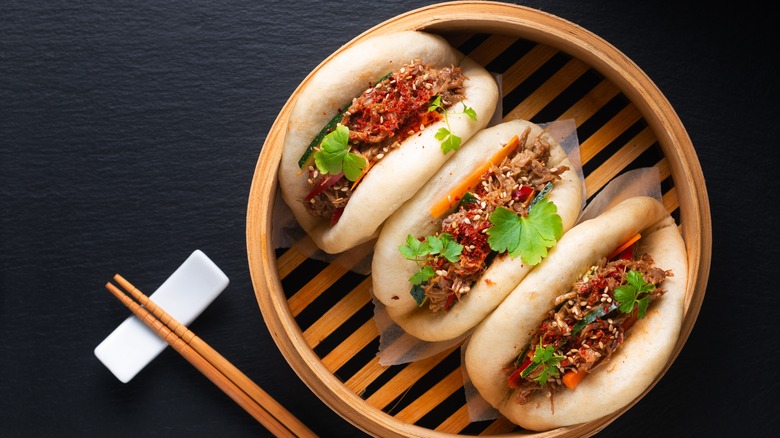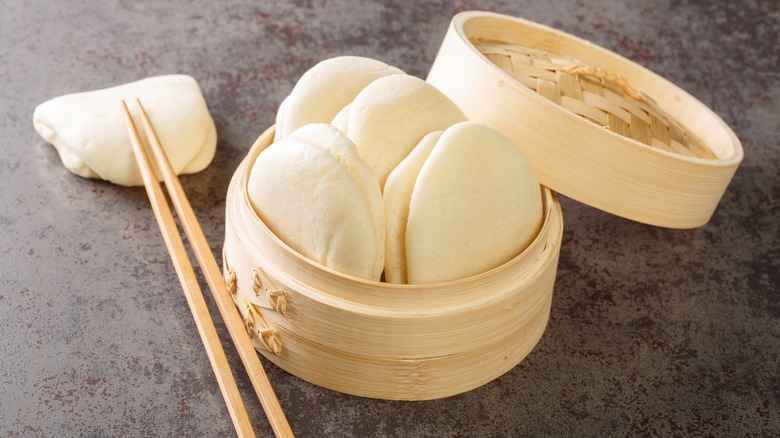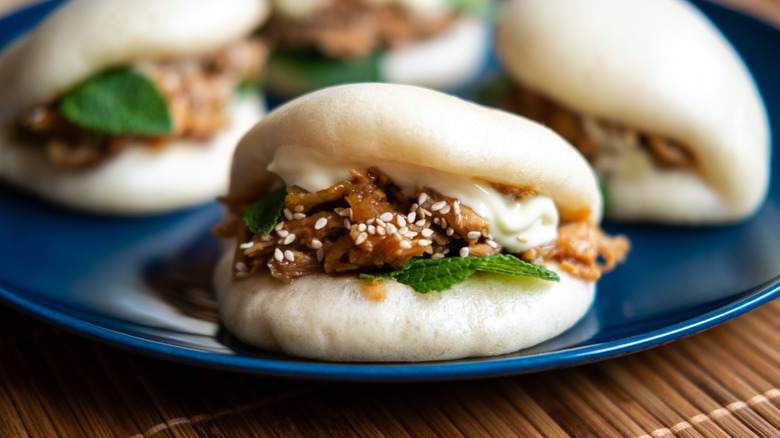The Common Mistake That Leads To Soggy Bao Buns
Bao buns are more popular than ever these days, with analytics company Glimpse reporting that interest in the food rose 8% in 2023. These softs buns originally hail from China, with some evidence showing they were eaten as early as 400 BCE. Part of their long tradition is still seen in the methods in which they are made.
At the heart of bao is a dough that's filled with ingredients like pork or scallions. The buns are fairly easy to make, relying on the simple alchemy of ingredients like water, flour, yeast, and sugar to form a soft, pliant mixture. But, rather than being baked, bao buns are gently steamed. This is what gives them their light, airy texture.
So, when you go to cook your buns, there's one important thing to keep in mind: What kind of steamer are you using? For many U.S. cooks, a stainless steel metal steamer might be the only option in the kitchen. For this task, however, this won't be the best tool in your arsenal. In order to avoid soggy buns, you may want to turn to a bamboo steamer, which cuts down on excess moisture.
Once you master the preparation steps, bao can be used for everything from traditional Shanghai soup dumplings to modern innovations, such as swapping out tortillas with bao for next level birria tacos.
Using a bamboo steamer
Bamboo steamers are made of a thin piece of wood that has uniform holes placed through the bottom. A ring of thicker bamboo is attached around the base, completing the construction. Because it's made of wood, this kind of steamer offers a huge benefit over metal devices — namely, bamboo will absorb condensation during the cooking process, whereas metal options will collect that condensation and drop it onto the food. This isn't a problem for all ingredients, but it certainly is for bao buns. If condensation gets released onto them while they cook, they'll end up water-logged and soggy. This holds true for cooking store-bought bao as well as from-scratch versions.
To use a bamboo steamer, simply place it in a large pot or pan that is filled with at least an inch of water. This will help it float so that the part of the steamer where your food rests will never touch the water. Next, bring your water to a boil. Once it's bubbling, turn the heat to medium-low and add your bamboo steamer to the pot. Close the lid tightly, and the hot steamed trapped inside will cook your bao.
Bamboo steamers also offer the added benefit of being stackable. You can place multiples on top of each other when cooking, which allows you to cook larger amounts of food at once. With your steamer set up, you can tackle buns or any other steamed recipe like umami-laden traditional Chinese steamed eggs.
Hacks to make bao without a bamboo steamer
This isn't to say you can't make bao buns if you don't have a bamboo steamer. All it takes is a little forethought and you can transform your metal steamer into a similar workhorse.
Let's say you're craving some Chinese roast chicken buns, but the only steamer you own is made of stainless steel. There's a hack to make it possible to create the perfect dish. Just tightly wrap a clean kitchen towel around your traditional metal steamer lid. It will absorb the condensation, protecting your bao buns from excess moisture just like a bamboo option would.
Another easy trick will make sure your bao buns don't stick. Unlike other items such as vegetables, pliable bao dough has a tendency to cling to surfaces. A quick way to avoid this is to use a perforated parchment insert.
To create your own insert, fold a piece of parchment paper in on itself multiple times. Stop once it has formed a fairly tight triangle. Cut the edges off the triangle, which will eventually give your unfolded paper a circular shape. Then snip some small holes on the sides and unfold. The holes you snipped will allow steam to travel through the piece of paper, and the paper itself will protect your buns from sticking. With these tips, all that's left is to decide what kind of bao to make!



